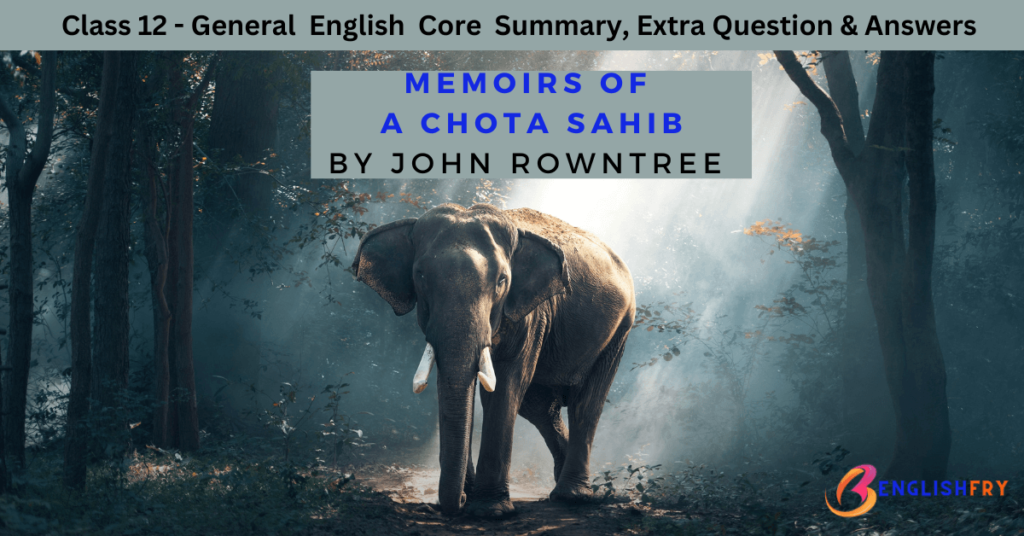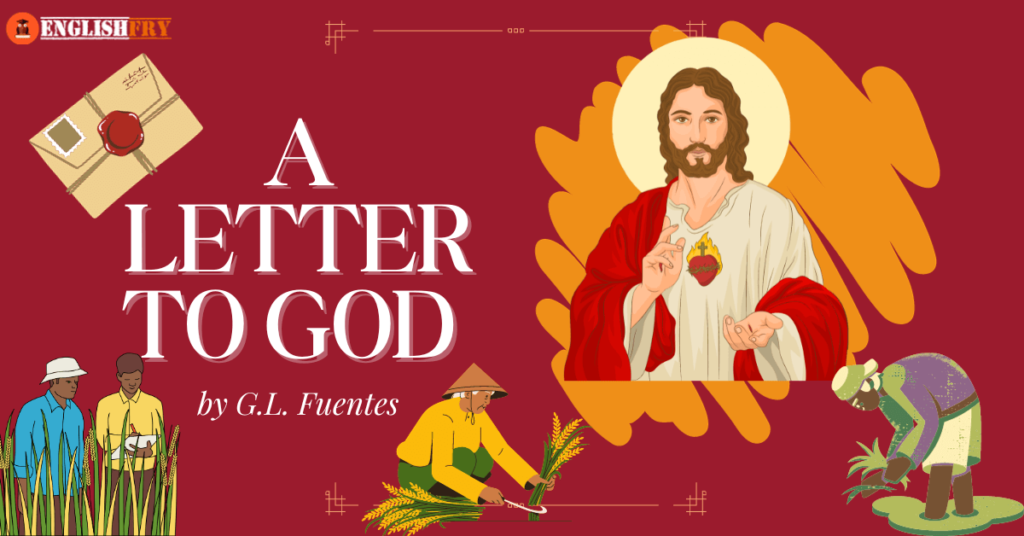Table of Contents
ToggleMemoirs of a Chota Sahib Summary
Memoirs of a Chota Sahib, written by John Rowntree, is a description of his experiences while residing in Gauhati. He begins the narrative work by telling us that, after a tiresome journey across India, he had arrived in Gauhati. He and his family were given access to a bungalow on the banks of the great Brahmaputra by the Public Works Department. The Brahmaputra’s beautiful grandeur, including Peacock Island’s Hindu temple dome, fascinated him from the bungalow. People had to travel via Gauhati to reach other districts higher up the valley at the time since it served as the entrance to Assam.
When he was staying at the bungalow in Gauhati, he occasionally had some strange visits. One of them was probably a big cat, as evidenced by the traces left by its feet. Both riverbanks were added to the Kamrup district. Its main office was in Gauhati. According to the author, the Brahmaputra sandbanks and the Himalayan foothills are separated by a long, isolated length of flat, ageless terrain on the north bank. In the hot heat, the river totally dried up and vanished underground, causing a peculiar occurrence to be observed on this land.
He recounts his encounter with unclean water that they had to dig for. There were many bheels filled to the brim with peafowl and wildfowl. There are two rhinos in the Manas Sanctuary. Mahseer, a type of fish, was common in the rivers. Rowntree was also instructed to construct the Governor’s Christmas camps along the river, for which the Governor occasionally wrote a thank-you note. He once witnessed a charming sight of a sloth bear carrying her cub on her back. During the wet season, malaria was rife on the North Bank.
The area had flood damage, bridges made of bamboo were destroyed, etc. The author once had a terrible time trying to ride his horse through a flooded river. He used the horse’s tail as a rudder by slipping over its croup and hanging on to it. They eventually achieved a safe landing on the other side of the river when the horse adjusted its course when he nudged it to the right or the left. Mar boats were used as a form of transportation at that time. The mar boats crossed the river either by paddling them or by running cables from one to another. The force of the current pushed them from one side to the other.
The author had an unpleasant encounter as part of a family visit to the North Bank. When they arrived, it was late and the road was so slippery that accidents could happen at any time. They slithered six feet below the road, into a rice field. They finally managed to re-enter the highway.
The South Bank seems cosier to the author. It had shorter distances and more compact terrain. There were many small hills and valleys in the area. They were provided with two cosy bungalows, one in Kulsi and the other at Rajapara. In the guesthouse at Rajapara, the author had a terrifying experience with the bats. Their foul body odour and droppings served as continual reminders of their presence. Near the bungalows, there was a sizable quake-induced crater that served as a reminder that the area was formerly dry land.
At Kulsi, teak plantations encircled the bungalow. Additionally, there was a Ficus elastica rubber plantation, but there had not been any tapping for a number of years because Indian rubber was no longer able to commercially compete with para rubber.

Memoirs of a Chota Sahib Summary in Hindi
छोटा साहिब के संस्मरण सारांश
जॉन रॉनट्री द्वारा लिखित छोटा साहिब के संस्मरण, गौहाटी में रहने के दौरान उनके अनुभवों का वर्णन है। उन्होंने कथात्मक कार्य की शुरुआत यह बताकर की कि, भारत भर में एक थकाऊ यात्रा के बाद, वे गौहाटी पहुँचे थे। उन्हें और उनके परिवार को लोक निर्माण विभाग द्वारा महान ब्रह्मपुत्र के तट पर एक बंगले में रहने की अनुमति दी गई थी। ब्रह्मपुत्र की सुंदर भव्यता, जिसमें मयूर द्वीप के हिंदू मंदिर का गुंबद भी शामिल है, ने उन्हें बंगले से ही मोहित कर लिया। उस समय घाटी के ऊपर अन्य जिलों तक पहुँचने के लिए लोगों को गौहाटी से होकर यात्रा करनी पड़ती थी क्योंकि यह असम का प्रवेश द्वार था।
जब वे गौहाटी में बंगले में रह रहे थे, तो कभी-कभी उनके यहाँ कुछ अजीबोगरीब लोग आते थे। उनमें से एक शायद एक बड़ी बिल्ली थी, जैसा कि उसके पैरों के निशानों से पता चलता है। दोनों नदी तटों को कामरूप जिले में जोड़ा गया था। इसका मुख्य कार्यालय गौहाटी में था। लेखक के अनुसार, ब्रह्मपुत्र रेतीले टीले और हिमालय की तलहटी उत्तरी तट पर समतल, चिरस्थायी भूभाग की एक लंबी, अलग-थलग लंबाई से अलग हैं। भीषण गर्मी में, नदी पूरी तरह से सूख गई और भूमिगत हो गई, जिससे इस भूमि पर एक अजीबोगरीब घटना देखी गई।
वह अशुद्ध पानी के साथ अपने मुठभेड़ को याद करता है जिसे उन्हें खोदना पड़ा था। मोर और जंगली पक्षियों से भरी कई भीलें थीं। मानस अभयारण्य में दो गैंडे हैं। नदियों में एक प्रकार की मछली, महसीर आम थी। रोनट्री को नदी के किनारे राज्यपाल के क्रिसमस शिविरों का निर्माण करने का भी निर्देश दिया गया था, जिसके लिए राज्यपाल ने कभी-कभी एक धन्यवाद नोट लिखा था। उन्होंने एक बार एक सुस्त भालू को अपनी पीठ पर अपने शावक को ले जाते हुए एक आकर्षक दृश्य देखा। बारिश के मौसम के दौरान, उत्तरी तट पर मलेरिया व्याप्त था।
क्षेत्र में बाढ़ से नुकसान हुआ था, बांस से बने पुल नष्ट हो गए थे, आदि। लेखक को एक बार बाढ़ वाली नदी में अपने घोड़े पर सवार होकर जाने की कोशिश करते हुए बहुत बुरा लगा था। उन्होंने घोड़े की दुम को पतवार की तरह इस्तेमाल किया और उसके ऊपर से फिसलकर लटक गए। जब उन्होंने घोड़े को दाएं या बाएं घुमाया तो घोड़े ने अपना रास्ता बदल लिया और वे आखिरकार नदी के दूसरी तरफ सुरक्षित उतर गए। उस समय परिवहन के साधन के रूप में मार नावों का इस्तेमाल किया जाता था। मार नावें या तो पैडल मारकर या केबल बिछाकर नदी पार करती थीं। धारा का बल उन्हें एक तरफ से दूसरी तरफ धकेलता था।
लेखक को उत्तरी तट पर एक पारिवारिक यात्रा के दौरान एक अप्रिय मुठभेड़ का सामना करना पड़ा। जब वे पहुंचे, तो देर हो चुकी थी और सड़क इतनी फिसलन भरी थी कि कभी भी दुर्घटना हो सकती थी। वे सड़क से छह फीट नीचे चावल के खेत में जा गिरे। वे आखिरकार राजमार्ग पर फिर से प्रवेश करने में सफल रहे।
लेखक को दक्षिणी तट अधिक आरामदायक लगता है। इसकी दूरी कम थी और भूभाग अधिक सघन था। इस क्षेत्र में कई छोटी पहाड़ियाँ और घाटियाँ थीं। उन्हें दो आरामदायक बंगले दिए गए थे, एक कुलसी में और दूसरा राजापारा में। राजापारा के गेस्टहाउस में लेखक को चमगादड़ों के साथ एक भयानक अनुभव हुआ। उनके शरीर की दुर्गंध और मल लगातार उनकी मौजूदगी की याद दिलाते रहते थे। बंगलों के पास, भूकंप के कारण एक बड़ा गड्ढा था जो याद दिलाता था कि यह इलाका पहले सूखी ज़मीन था।
कुलसी में, बंगले के चारों ओर सागौन के बागान थे। इसके अलावा, वहाँ फ़िकस इलास्टिका रबर का बागान था, लेकिन कई सालों से वहाँ कोई टैपिंग नहीं हुई थी क्योंकि भारतीय रबर अब पैरा रबर के साथ व्यावसायिक रूप से प्रतिस्पर्धा करने में सक्षम नहीं था।

Memoirs of a Chota Sahib Summary in Assamese
এটা ছোটা চাহাবৰ সাৰাংশৰ স্মৃতিগ্ৰন্থ
জন ৰাউনট্ৰিৰ দ্বাৰা ৰচিত Memoirs of a Chota Sahib ত গৌহাটীত বাস কৰাৰ সময়ত তেওঁৰ অভিজ্ঞতাৰ বৰ্ণনা। তেওঁ আখ্যানমূলক কামৰ আৰম্ভণিতে আমাক কয় যে, ভাৰতবৰ্ষৰ এক ক্লান্তিকৰ যাত্ৰাৰ অন্তত তেওঁ গৌহাটীত উপস্থিত হৈছিল। তেওঁক আৰু তেওঁৰ পৰিয়ালক মহান ব্ৰহ্মপুত্ৰৰ পাৰত থকা বাংলোত প্ৰৱেশৰ সুবিধা ৰাজহুৱা কাম বিভাগে দিছিল। ময়ুৰ দ্বীপৰ হিন্দু মন্দিৰৰ গম্বুজকে ধৰি ব্ৰহ্মপুত্ৰৰ সুন্দৰ ভৱিষ্যৎ বাংলোৰ পৰাই তেওঁক মুগ্ধ কৰি তুলিছিল। সেই সময়ত উপত্যকাৰ ওখ আন জিলালৈ যাবলৈ গৌহাটী হৈ মানুহে যাত্ৰা কৰিবলগীয়া হৈছিল যিহেতু ই অসমৰ প্ৰৱেশদ্বাৰ হিচাপে কাম কৰিছিল।
গৌহাটীৰ বাংলোটোত থাকি থাকোঁতে মাজে মাজে তেওঁৰ কিছুমান অদ্ভুত ভ্ৰমণ আহিছিল। তাৰে এটা হয়তো ডাঙৰ মেকুৰী আছিল, যাৰ প্ৰমাণ ভৰিৰে এৰি থৈ যোৱা লেখ-জোখৰ পৰাই পোৱা যায়। দুয়োটা নদীৰ পাৰ কামৰূপ জিলাত সংযোজন কৰা হ’ল। ইয়াৰ মূল কাৰ্যালয় আছিল গৌহাটীত। লেখকৰ মতে ব্ৰহ্মপুত্ৰৰ বালিৰ পাৰ আৰু হিমালয়ৰ পাদদেশ উত্তৰ পাৰৰ দীঘলীয়া, বিচ্ছিন্ন দৈৰ্ঘ্যৰ সমতল, বয়সহীন ভূখণ্ডৰ দ্বাৰা পৃথক। গৰম গৰমত নদীখন সম্পূৰ্ণৰূপে শুকাই মাটিৰ তলত নোহোৱা হৈ গ’ল, যাৰ ফলত এই ভূমিত এক অদ্ভুত পৰিঘটনা দেখা গ’ল।
তেওঁ অশুচি পানীৰ সৈতে হোৱা মুখামুখিৰ কথা কয়, যিটো পানীৰ বাবে তেওঁলোকে খান্দিবলগীয়া হৈছিল। মটৰ চৰাই আৰু বনৰীয়া চৰাইৰে ঠেংলৈকে বহু ভীল ভৰি পৰিছিল। মানস অভয়াৰণ্যত আছে দুটা গঁড়। মাছিৰ নামৰ এক প্ৰকাৰৰ মাছ নদীবোৰত প্ৰচলিত আছিল। ৰাউনট্ৰিক নদীৰ কাষত গৱৰ্ণৰৰ খ্ৰীষ্টমাছ শিবিৰ নিৰ্মাণ কৰিবলৈও নিৰ্দেশ দিয়া হৈছিল, যাৰ বাবে গৱৰ্ণৰে মাজে মাজে ধন্যবাদৰ পত্ৰ লিখিছিল। এবাৰ তেওঁ এটা মনোমোহা দৃশ্যৰ সাক্ষী হৈছিল, য’ত এটা অলস ভালুকে নিজৰ পোৱালিটোক পিঠিত লৈ ফুৰিছিল। আৰ্দ্ৰ বতৰত উত্তৰ পাৰত মেলেৰিয়াৰ প্ৰকোপ আছিল।
অঞ্চলটোত বানপানীৰ ক্ষয়-ক্ষতি হৈছিল, বাঁহেৰে নিৰ্মিত দলংবোৰ ধ্বংস হৈছিল ইত্যাদি।এবাৰ বানপানী নদীৰ মাজেৰে ঘোঁৰাত উঠিবলৈ চেষ্টা কৰি লেখকে ভয়ংকৰ সময় পাৰ কৰিছিল। ঘোঁৰাৰ ঠেংখন তাৰ ক্ৰুপৰ ওপৰেৰে পিছলি গৈ তাৰ ওপৰত ওলমি ৰুডাৰ হিচাপে ব্যৱহাৰ কৰিছিল। অৱশেষত ঘোঁৰাটোৱে সোঁফালে বা বাওঁফালে ঠেলি দিলে নিজৰ গতিপথ সামঞ্জস্য কৰি ল’লেই তেওঁলোকে নদীৰ সিটো পাৰে নিৰাপদ অৱতৰণ কৰিব পাৰিলে। সেই সময়ত পৰিবহণৰ এক প্ৰকাৰ হিচাপে মাৰ নাও ব্যৱহাৰ কৰা হৈছিল। মাৰ নাওবোৰে হয় পেডেল মাৰি নহয় ইখনৰ পৰা সিখনলৈ কেবল চলাই নদীখন পাৰ হৈছিল। সোঁতৰ বলত সিহঁতক এফালৰ পৰা সিফাললৈ ঠেলি দিলে।
নৰ্থ বেংকলৈ পাৰিবাৰিক ভ্ৰমণৰ অংশ হিচাপে লেখকৰ এটা অপ্ৰীতিকৰ মুখামুখি হৈছিল। তেওঁলোক আহি পোৱাৰ সময়ত দেৰি হৈছিল আৰু ৰাস্তাটো ইমানেই পিছল আছিল যে যিকোনো সময়তে দুৰ্ঘটনা সংঘটিত হ’ব পাৰে। ৰাস্তাৰ পৰা ছয় ফুট তলত, ধাননি পথাৰ এখনত সোমাই গ’ল। অৱশেষত তেওঁলোকে পুনৰ ঘাইপথত প্ৰৱেশ কৰিবলৈ সক্ষম হ’ল।
লেখকৰ বাবে চাউথ বেংকটো অধিক আৰামদায়ক যেন লাগে। ইয়াৰ দূৰত্ব কম আৰু অধিক কমপেক্ট ভূখণ্ড আছিল। সৰু সৰু পাহাৰ, উপত্যকা আদিৰ দৰে ঠাইৰ পৰা ওলাই আহিছিল। দুটা আৰামদায়ক বাংলোৰ ব্যৱস্থা কৰা হৈছিল, এটা কুলছিত আৰু আনটো ৰাজাপাৰাত। ৰাজাপাৰাৰ অতিথিশালাত লেখকে বাদুলিৰ সৈতে এক ভয়ংকৰ অভিজ্ঞতা লাভ কৰিছিল। তেওঁলোকৰ শৰীৰৰ দুৰ্গন্ধ আৰু মল-মূত্ৰই তেওঁলোকৰ উপস্থিতিৰ নিৰন্তৰ সোঁৱৰণী হিচাপে কাম কৰিছিল। বাংলোবোৰৰ ওচৰতে ভূমিকম্পৰ ফলত হোৱা এটা ডাঙৰ ক্ৰেটাৰ আছিল যিয়ে সেই অঞ্চলটো পূৰ্বতে শুকান ভূমি বুলি সোঁৱৰাই দিয়াৰ কাম কৰিছিল।
কুলচিত চেগুন বাগিচাই বাংলোটোক আগুৰি ধৰিছিল। ইয়াৰ উপৰিও ফিকাছ ইলাষ্টিকা ৰবৰৰ বাগিচা আছিল যদিও ভাৰতীয় ৰবৰে পেৰা ৰবৰৰ সৈতে ব্যৱসায়িকভাৱে প্ৰতিযোগিতাত অৱতীৰ্ণ হ’ব পৰা নাছিল বাবে কেইবাবছৰ ধৰি কোনো ধৰণৰ টেপিং হোৱা নাছিল।

Think as you read-I
- Briefly describe the scene observed by the author from the veranda of his bungalow on the bank of the Brahmaputra.
Answer: The author and his family arrived in Guwahati after a long, dusty journey across India, and settled in a bungalow on the banks of the Brahmaputra. The climate was quite bearable due to the approaching cold weather. The veranda on top of the bungalow provided a breathtaking view of the majestic river and the boats that sailed along with it. The lower Himalayas could be seen in the distance, while a Hindu temple dome could be seen on an island called Peacock Island. This dome was almost completely obscured by trees.
- What is the belief about the dividing channel between Peacock Island and the mainland of Guwahati that the author mentions?
Answer: The level of the Brahmaputra fell as the cold weather progressed, and the water distance between Peacock Island and the mainland shrank. Only a narrow dividing channel remained at the end of the hot weather. There was a widespread belief in India that the British Raj would end if the channel dried up completely. Although this route did occasionally dry up significantly, the author could not comment on whether one could walk on a dry channel during the time of independence in 1947 because he did not live in Gauhati at the time.
- What does the author say about the importance of Guwahati? Is the statement true in our time today as well?
Answer: The author emphasises the significance of Guwahati by describing it as Assam’s port of entry. Most travellers used to pass through Guwahati on their way from Calcutta to Shillong or to districts further up the valley. They stayed overnight there on occasion to rest. Yes, the statement still holds true today. Guwahati, which still connects the rest of India to all of the states in the North-East region, is known as the gateway to North-East India. Every year, tourists from all over the country and abroad flock to Guwahati, particularly as a stopover on their way to other parts of North-East India.
Think as you read-II
- What character of the North Bank of the Brahmaputra does the author refer to?
Answer: The North Bank, which lay between the Brahmaputra sandbanks and the Himalayan foothills, was a vast, solitary expanse of flat, ageless land. The rivers in this area were unusual in that they either dried up or vanished underground during hot weather. Dwellers in the area had to dig for water, which was so muddy that it had to be cleaned with alum to precipitate the mud.
- What information does the author give us about Manas Wildlife Sanctuary?
Answer: A few rhinoceros lived in the Manas Wildlife Sanctuary, which bordered the Himalayan state of Bhutan. The rivers were teeming with mahseer, and the Governor’s Christmas camps were popular hangouts. The sanctuary also housed Assam cheetal, sloth-bear, and deer. A European and his wife have leased a plot of land from the forest department to grow simul trees for the nearby match factory. To keep the deer out, the area was surrounded by miles of electric fencing.
- Describe the author’s experience of crossing a flooded river on horseback on the North Bank of the Brahmaputra.
Answer: The author has written a humorous account of an adventurous horseback ride he once took to cross one of the North Bank’s flooded rivers. He eventually persuaded the horse to jump into the river and slip over its rump. He clung to his tail and steered with it. The horse also added to the thrill of the ride by moving to the left when the writer attempted to push it to the right, and vice versa. This unforgettable adventure ended with a safe landing on the other side of the river.
Think as you read-III
- Relate the author’s experiences of the road accident during the monsoon on the North Bank.
Answer: The author was once on the North Bank with his family. He had either erroneously planned to return after the monsoon or the monsoon had arrived early that year. As a result, even though the roads were still passable, driving became extremely dangerous. The majority of the main roads were built on top of embankments to raise them above the normal flood level. These were narrow, single-track roads. While attempting to drive on an extremely slippery road, the author’s car lost control and began sliding along the road, eventually falling into a paddy field six feet below the road. The paddy fields on the North Bank were divided into enclosures by low banks to prevent flood water from running away. Driving over these banks was quite jerky, but they eventually made it back to the road.
- Relate the author’s reminiscence of the forest bungalow at Kulsi.
Answer: The author’s favourite bungalow was at Kulsi, which was situated in a raised and forested area above the river. The bungalow was surrounded by teak plantations that had been planted sixty years ago and were nearly fully grown. A rubber plantation of Ficus elastica was also located near the bungalow. However, the author recalls that it had not been tapped in a long time.
Understanding the text
- Give an account of the author’s experiences of the floods on the North Bank of the Brahmaputra during the monsoon.
Answer: The author describes various flood experiences on the Northern bank. He once rode his horse across a flooded river. He managed to get his horse to jump into the water, then climb atop it, use the horse’s tail to steer it, and successfully cross the river.
On another occasion, while touring the Northern Bank, he was caught in the rain. Driving over raised embankments was difficult, and his car slid into a paddy field. Riding over the fields’ banks was jerky, but he got back on the road. During floods, the river was crossed by special boats, with landing areas built at various levels depending on the water level.
- Relate the author’s observation on the use of mar boats as a mode of river transport in Assam.
Answer: The author mentions the use of special boats known as mar boats. This device was made up of two open boats that were covered with a platform made of wooden planks. Moving this device forward was time-consuming. It was either pedalled or propelled along a cable that linked the boats to another cable that stretched across the river. Despite its success, landing ghats had to be built at various levels along the bank to accommodate rising and falling river levels. According to the author, traffic was light, and crossing over took some time, but there were no major delays.
- Give the author’s description of a sal forest.
Answer: The author compares Assam’s sal forests to English woodlands. The sal forests were scattered across the South Bank’s flat terrain. The reserve forests, which primarily consisted of sal trees, were mostly in one block and were interspersed with villages and cultivation across this vast expanse of land.
- Describe the author’s experience with bats in the Rajapara forest bungalow.
Answer: The author believed that if it hadn’t been for the bats that lived on the roof, the Rajapara bungalow would have been quite appealing. The writer was constantly reminded of their presence by their excrement and stench. The colossal fruit-eating bats had a five-foot wing span and lived in a tree outside the bungalow. They flew out into the open after sunset in search of food, and the sight resembled an unexplainable cluster of eerie figures soaring in the sky on silent wings.
Extra questions and answers
- In the chapter “Memoirs of Chota Sahib,” who is referred to as “Chota Sahib”?
Answer: The “Chota Sahib” in “Memoirs of a Chota Sahib” is John Rowntree, the last British Senior Conservator of the Forests of Assam.
- Before departing Shillong a few days after independence, what position did John Rowntree hold?
Answer: Before departing Shillong a few days after independence, John Rowntree held the position of Senior Conservator of the Forests of Assam.
- Name the book that the lesson is an excerpt from.
Answer: A Chota Sahib: Memoirs of a Forest Officer is the source for the lesson Memoirs of a Chota Sahib.
Missing answers are only available to registered users. Please register or login if already registered
- Briefly describe the bheel near the Rajapara bungalow.
Answer: The Rajapara Forest bungalow was near a large bheel where a quake had pushed the surface down and flooded the land many years ago. Tree skeletons continued to emerge from the water, creating a creepy atmosphere and reminding visitors that this was once dry land.
- What information does the author provide about the Rajapara paddy field in Memoirs of a Chota Sahib?
Answer: Rajapara’s paddy fields were delightful, with sunlit and open spaces, and a pleasant place to work. After harvest, the jungle fowl congregated here to feed on the grains, and they occasionally found their way into the pot where the grains were stored.
- Recount the author’s account of a road accident in which his family’s car collided with a ramp that was hidden under a cloud of dust.
Answer: The roads had been so dusty at the start of the author’s journey, long before the monsoon showers, that they were almost hidden beneath a cloud of dust. It was a Herculean task to drive in such conditions. A ramp was hidden from view under a cloud of dust at one location where road work was being done. The warning signs were either not in use or were invisible. The author, his wife, the baby and her ayah, their servants, and some camp gear collided with the six-inch-high ramp hidden beneath a cloud of dust. Despite the fact that they collided with it with great force, they were unharmed because the car was completely packed. Because of the ingenious motor engineers of the time, the car was also unharmed in the accident.
- What details about Ficus elastica does the author in Memoirs of a Chota Sahib provide?
Answer: A Ficus elastica rubber plantation was very close to the Kulsi forest bungalow. This Indian rubber was unable to compete commercially with para rubber. Ficus elastica is a member of the fig family, of which Assam has many varieties. A few begin as climbing aerophytes on other trees and grow to enormous proportions. Over time, the host tree is completely covered by the ficus, which forms a smooth bark around it, and the host tree dies. Some, like the banyan tree, send down roots from their branches to help support the bulky tree.
Founder of Englishfry.com, a captivating and knowledge-driven blog & Founder of Android app/website Studyfunnel.com, an online Mock Test Series Portal. With a wealth of experience spanning over 16+ years, he has excelled as an Ex-Asst.Professor, Teacher, Amazon published author, Website Developer, Graphic Designer,Blogger,Poet, and Creative academic content writer publisher of 4 academic books available Online on Amazon & Flipkart. His tryst in Literature helped him realize his love for writing and telling stories. A tech-savvy language nerd by day and, a passionate writer by night, he now translates his experiences into tales of wisdom served with a side of humor.His widely recognized profound insights ,captivating writing style of weaving words make him contribute to prestigious publications and a sought-after authority in the field that transport readers to extraordinary worlds.








